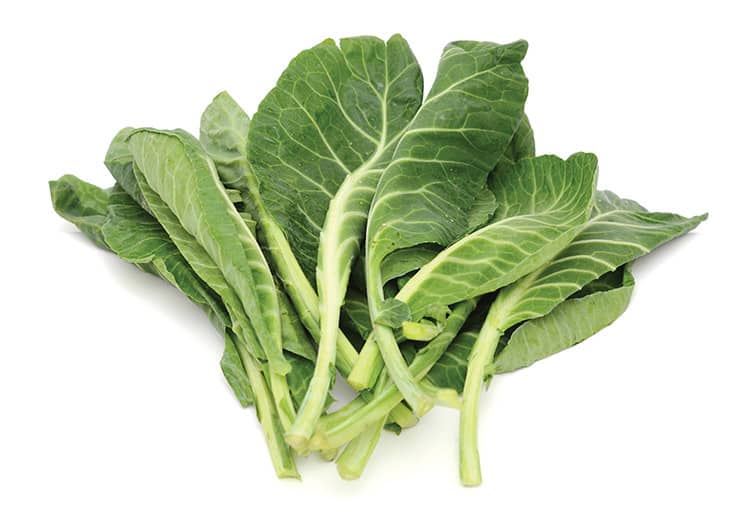
Move over, kale—it’s time for collard greens to step into the spotlight. The nutrient-dense, loose-leafed plant belongs to the same cruciferous vegetable species as Brussels sprouts, broccoli, and the aforementioned trendy green. Collards are also one of the oldest members of Brassica oleracea, with cultivation dating back to 5000 B.C. Asia—long before its present-day association with Southern soul food. Over the centuries, its availability expanded by way of trade routes, and the unassuming green was eventually grown and consumed by ancient Greeks and Romans, medieval Brits, and 17th-century American colonists alike.
Today, the veggie proliferates in warmer climates and, despite being eaten all over the world, is synonymous with the South (so much so that in 2011, South Carolina made it its official state vegetable). Collards are available year-round but hit their peak in late winter and early spring, when their broad, paddle-shaped leaves are kissed by frost and become sweet and tender. When shopping, seek out leaves that are waxy in texture with veins that are white and prominent—signs of good water content and freshness.
Collard greens are also one of the most nutritious vegetables you can eat; the leaves are rich in fiber, manganese, folate, and calcium, as well as vitamins K, A, C, and B6. Phytochemicals present in the leafy greens have also shown potential to reduce certain types of cancer and have been linked to reduced levels of “bad” cholesterol and a lower risk of heart disease according to recent studies.
Admittedly, when collard greens are slow-cooked with ham hocks, onions, and vinegar, they aren’t quite as heart-healthy, but according to Southern folklore, eating the leaves alongside cornbread and Hoppin’ John (a black-eyed pea and rice dish) on New Year’s Day will ensure wealth and luck for the year to come. Many know collards only by way of this time-honored preparation, but don’t stop there. Sautéed, the greens can be served as a side dish, added to pasta with lots of freshly grated parmesan or, for a Middle Eastern twist, mixed with labneh for a savory dip. Stir chopped collards into soups and stews as the Portuguese do with caldo verde (“green broth”) or give the raw greens a massage treatment as you would kale for a hearty, nutritious salad.
Whether you eat them for luck or for health, collard greens are versatile and delicious—and they’re ready for their close-up.
Collard Green Salad with Spiced Sweet Potatoes, Fresh Chèvre, and Peanuts
Ingredients
- SPICED SWEET POTATOES:
- 2 sweet potatoes 1½ to 2 pounds total, cut into ½-inch cubes
- 2 teaspoons Ethiopian berbere spice
- 1½ teaspoons kosher salt
- 2 cloves garlic minced
- 2 tablespoons olive oil
- LEMON-TAHINI DRESSING:
- ¼ cup tahini
- 1 lemon zested and juiced
- 1 tablespoon white wine vinegar
- 1 teaspoon kosher salt plus more to taste
- ¾ cup olive oil
- ASSEMBLY:
- 1 bunch collard greens stems removed and leaves cut into ½-inch ribbons (about 6 cups total)
- Kosher salt to taste
- ½ large watermelon radish thinly sliced
- ¼ cup crumbled fresh chèvre
- ¼ cup roasted unsalted peanuts, roughly chopped
Instructions
- SPICED SWEET POTATOES: Heat oven to 375°F. Toss sweet potatoes with berbere spice, salt, garlic, and olive oil in a medium bowl. Transfer to a baking sheet and roast for 25 minutes, or until fork-tender. Set aside to cool.
- LEMON-TAHINI DRESSING: Meanwhile, combine tahini, lemon zest and juice, vinegar, salt, and olive oil in a food processor and pulse until smooth. Season to taste as necessary.
- ASSEMBLY: Using your hands, toss collard greens with 4 to 5 tablespoons dressing (or as much as needed to lightly, evenly dress the greens) and a pinch or two of salt in a large serving bowl. Top with sweet potatoes, radish, chèvre, and peanuts. Serve with remaining dressing on the side, if desired.



